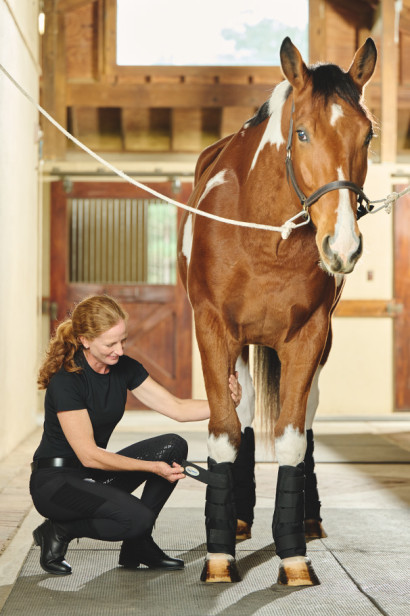Equine Therapy Programs: Transforming Lives One Ride at once
Equine Therapy Programs: Transforming Lives One Ride at once
Blog Article
Assessing the Performance of Laser Treatment in Equine Treatment for Injury Rehabilitation
The examination of laser treatment's performance in equine injury recovery pivots on several aspects, consisting of healing time, pain mitigation, and tissue regeneration. Veterinarians frequently observe exceptional results with laser treatment contrasted to traditional techniques, positioning it as a vital element in equine care.
Understanding Laser Treatment
Laser therapy has actually become a crucial device in veterinary medication, especially in the treatment of equine problems. Known for its non-invasive nature and effectiveness, laser therapy involves the application of details wavelengths of light to boost cells repair work and reduce inflammation. This healing technique is progressively favored for its capacity to speed up the healing procedure in horses struggling with a range of musculoskeletal injuries and chronic problems.
The primary mechanism behind laser therapy is its capacity to enhance mobile features. When laser light permeates the skin, it is taken in by mitochondria, the powerhouse of cells, which causes boosted manufacturing of adenosine triphosphate (ATP) This biochemical energy boost promotes mobile repair work and regeneration. In addition, laser therapy promotes vasodilation, boosting blood circulation and oxygen distribution to damaged cells, therefore speeding up recovery.
In equine medicine, laser therapy is especially beneficial for conditions such as tendonitis, osteo arthritis, and wound healing. The technique is lauded for its pain-relieving residential or commercial properties, enabling equines to reclaim flexibility and function a lot more swiftly. Vets additionally value its marginal side results contrasted to other treatment techniques, making it a reliable and risk-free option for equine treatment.

How Laser Treatment Functions

Upon absorption, these photons trigger a collection of biochemical modifications, boosting mitochondrial feature and causing boosted adenosine triphosphate (ATP) manufacturing. This rise in ATP accelerates cellular metabolic process, promoting cells fixing and regeneration. In addition, laser therapy modulates inflammatory reactions by affecting cytokine levels and reducing oxidative anxiety, thus relieving discomfort and swelling.
One more considerable facet of laser treatment is its function in improving microcirculation. The therapy advertises vasodilation, enhancing blood circulation and oxygen shipment to damaged cells (Equine Therapy). This assists in the removal of mobile particles and supports the spreading of fibroblasts and collagen synthesis, critical for injury recovery
Scientific Evidence
The effectiveness of laser treatment in equine treatment has actually been confirmed via various scientific researches, showcasing its therapeutic potential throughout a range of conditions. A research conducted by Turner et al. (2012) showed that equines treated with low-level laser therapy (LLLT) for tendon injuries displayed accelerated recovery contrasted to those getting traditional treatments.
In a similar way, research study by Johnson and colleagues (2015) concentrated on equine muscle injuries, disclosing that laser treatment dramatically expedited muscular tissue fiber regrowth and reduced muscular tissue stiffness. These findings were affirmed by histological analyses revealing enhanced muscle cells company. Additionally, clinical analyses have actually revealed that laser treatment can alleviate persistent problems such as osteo arthritis. A research by Smith et al. (2018) reported that horses with osteoarthritic joints experienced noteworthy pain relief and raised series of motion complying with a program of laser treatment sessions.
Vet Insights

Veterinarians additionally you can look here appreciate the adaptability of laser treatment. She aims out that laser therapy can be tailored to the details demands of each steed, guaranteeing optimum end results.
Additionally, vets value the capability to integrate laser treatment with other treatment techniques. This multimodal method can boost general therapy efficacy, giving a thorough remedy for equine rehab. Such recommendations from seasoned professionals emphasize the growing acceptance and application of laser treatment in equine medication.
Practical Factors To Consider
A crucial element of applying laser therapy in equine treatment entails comprehending the practical factors to consider that ensure its effectiveness and safety. It is vital to choose the appropriate laser gadget, as numerous types vary in wavelength, power, and penetration deepness. Veterinarians should be skilled in these criteria to customize treatment procedures properly to every injury kind
Furthermore, the regularity and period of laser treatment sessions need mindful preparation to take full advantage of healing advantages while decreasing any possible unfavorable effects. Regular surveillance of the horse's feedback to therapy can guide needed modifications in the therapy routine. Developing a secure and controlled environment throughout treatments is additionally important to avoid accidental direct exposure to laser discharges, which might damage both the horse and the trainer.
Educating and qualification of workers carrying out laser treatment are vital to make certain proper technique and to maintain security standards. In addition, preserving exact documents of each session, consisting of laser setups and observed results, is crucial for assessing the total efficiency of the treatment and for making data-driven decisions.
Conclusion
Laser therapy has arised as an efficient method in equine injury recovery, supplying substantial benefits in recovery time, discomfort alleviation, and cells recovery. Medical research studies highlight considerable renovations in conditions such as tendonitis and osteo arthritis, credited to boosted cellular function and raised ATP production. Veterinarian observations support these searchings Equine Therapy for, highlighting exceptional outcomes compared to typical therapies. For optimal results, constant tracking and personalized therapy protocols remain necessary in leveraging the full possibility of laser therapy in equine treatment.
Report this page